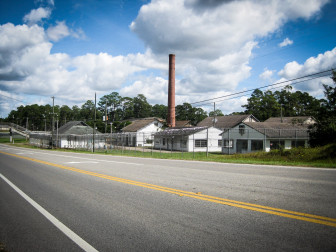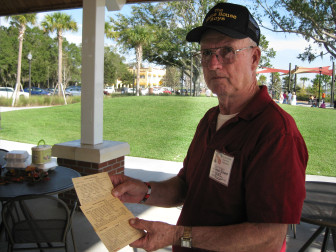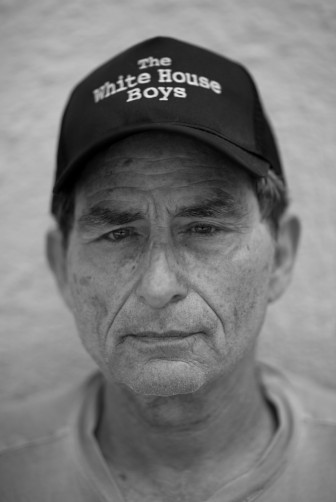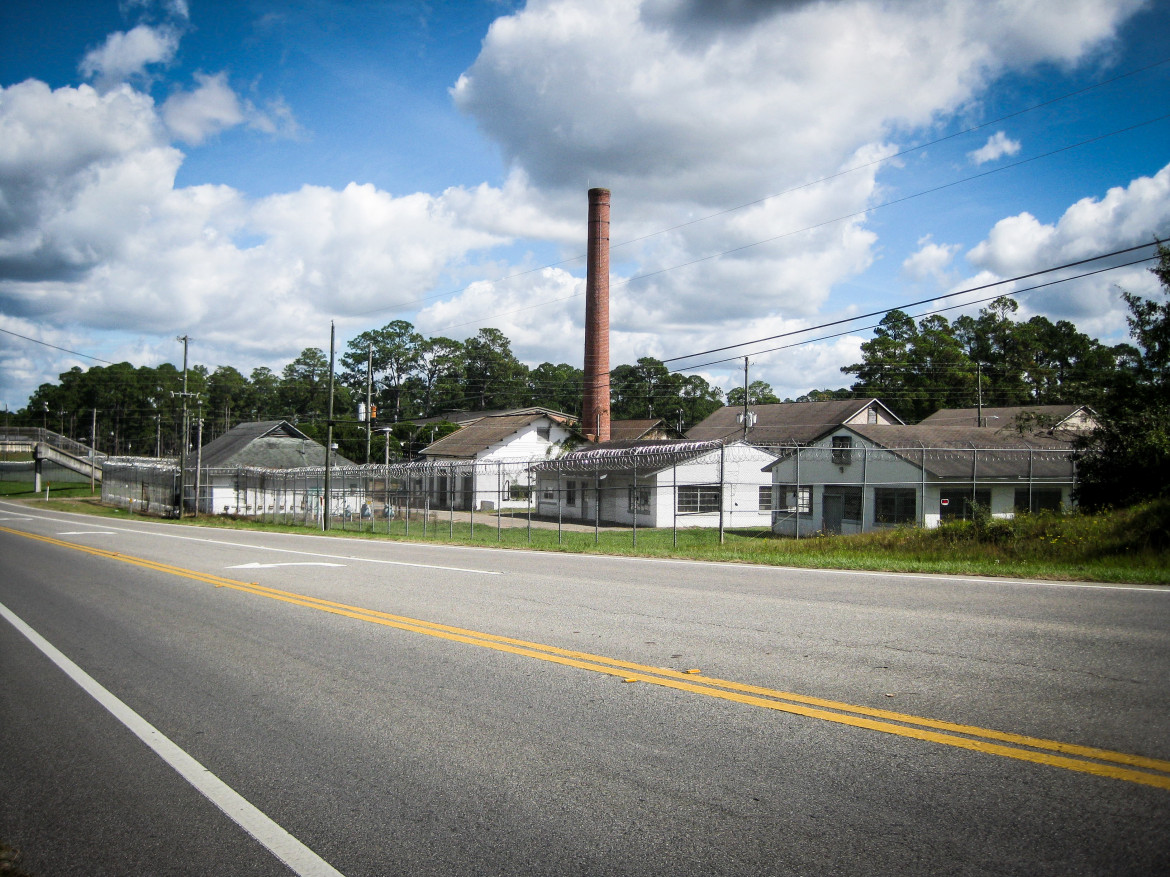Decades later, their experiences at a notorious Florida facility still haunts the men who were confined there as boys.
MARIANNA, Fla. -- The Florida School for Boys housed kids for six decades before Michael Tucker was sent there. An “incorrigible youth,” Tucker arrived at the facility, nestled deep in the woodlands of the Florida panhandle, in 1960. He was 16 years old.
There, Tucker received three severe beatings, he says, one of which left him hospitalized for five days. “They decided to send me off and straighten me out,” Tucker, who is now 69, said. “They sent me up there, and beat the hell out of me.”
Tucker worked in the school’s kitchen. He recalls an 11-year-old child with a nervous tic: when the boy came down the chow line, Tucker would always give him extra servings.

Daniel LeClair / JJIE
Michael Tucker was sent to the Florida School for Boys in 1960 when he was 16 years old. There, Tucker received three severe beatings, he says, one of which left him hospitalized for five days.
One day, school officials ordered Tucker into a small building on campus known as the White House, where hundreds of former residents alleged to have received violent whippings.
Tucker saw the boy from the chow line inside the building. He was lying on a bed, sobbing and yelling.
“They made me get at the head of that bed, pull his arms up behind his back, while another boy held his feet,” Tucker said. “While they beat him, he was sitting near my face, screaming for his mama.”
After that incident, Tucker says, the young boy could no longer look him in the eye when he passed through the cafeteria, and that hurt worse than any lashing.
Stories like this are not unusual among former Florida School for Boys residents. Others recall being dragged out of their beds in the middle of the night -- “going down,” they called it. They allege guards beat them with leather straps at the White House, some saying they received more than 100 lashes per incident. The guards would turn on a loud fan to muffle the boys’ screaming.
Several men claim school personnel molested them. Others allege some of the school’s staff went so far as to murder boys held there.
The psychological and physical trauma followed many into adulthood. The memories of their abuse, they say, are as vivid and emotionally taxing to them today as they were a half century ago.
>> See more portraits of the White House Boys on Bokeh, JJIE's art blog, HERE <<
When they grew up, some boys became drifters, some became alcoholics and many ended up as felons. But others grew up to be pastors, high-ranking corrections officials and businessmen. A few even became multimillionaires.
Despite their varied outcomes, the “White House Boys,” as they call themselves, remain unified by their shared childhood experiences. After decades of silence, they came together once more, reconnecting through the Internet and publicizing their abuses to the world at large.
Nobody Believed Us

James Swift / JJIE
Officially shut down in 2011, the Florida School for Boys in Marianna, Fla. was plagued by both allegations and confirmed accounts of abuse for more than a century.
The Florida State Reform School in Marianna operated for more than a century. Over the years, the school underwent a number of name changes. From its opening in 1900 to its official shuttering in 2011 -- when it was known as the Arthur G. Dozier School for Boys -- the facility was plagued by allegations and confirmed accounts of abuse and wrongdoing. By 1913, the facility had been the target of no less than six state investigations. Six months after its closing, the United States Department of Justice released a report confirming numerous incidents of staffers using excessive force on residents, along with “inappropriate uses of isolation and extensions of confinement for punishment and control.”
Allegations of resident abuse at the facility go as far back as 1903, including reports of children as young as 5 being chained to walls. Press clippings from the 1950s screamed headlines such as “State Board to Meet on Boy-Beating” and “Brutality Count to Be Aired.” In the early 1960s, one employee at the Okeechobee campus -- a southern Florida site opened in 1955 -- sent a resignation letter to then-director Arthur Dozier, which said, “Conditions here have been such that to continue would soon, very probably, mean professional suicide.” In the 1980s, a class-action lawsuit filed against the facility resulted in the outlawing of both the “hog-tying” of juvenile residents and placing them in isolation for weeks at a time.
Despite these reports, many of which were later corroborated by state and federal investigators, the White House Boys said few people believed them when they spoke of their experiences in Marianna and Okeechobee.
“When you try to tell this to anyone … they tend to blow you off,” said William Haynes, 70. He entered the facility in 1957, at the age of 14.
In 1958, Dr. Eugene Byrd, a psychologist who had worked at the Florida School for Boys, testified before a U.S. Senate committee. He described the beatings he witnessed.
“If they’re not going to believe him,” Haynes said, “they’re certainly not going to believe a 14-year-old boy.”
Brothers Charles and George Fudge both spent time at Marianna. Charles, 65, was 13 when he entered, while George, 67, was 14. Both served stints at the facility for grand theft.
“I never told anybody about the beating,” Charles said. “I think they put the fear in us that if we ever told anybody who came to visit, that we would get a beating much worse than the one we had received.”
George said he was told not to tell anyone about what he experienced. “Why tell if you’re going to get another beating?”
White House Boys President Dick Colon, 70, went to Marianna at age 13. He was sent to the facility in 1958 for car theft and incorrigibility -- in short, general disobedience of parents, teachers and other authority figures.
Colon stayed at the facility for 33 months, and he never told his family about his abuse.
Like many White House Boys, he resolved to forget about what he experienced.
No One Ever Said Stop

James Swift / JJIE
Currently the site of an ongoing excavation, the Florida School for Boys in Marianna, Fla. was in operation for more than 100 years.
“It was such a beautiful place,” said Claude Robins, 75, as he recounted his first day at Marianna. “Great big pine trees, nice dormitories.”
He went into the facility in 1953, at the age of 14. He spent 16 months at the campus for the crimes of theft and “waywardness” -- like “incorrigibility,” it was something of a catchall for juvenile misbehavior.
“One day, I just ran,” Robins said. Later that evening, a state employee apprehended him. “I think they earned $25 a piece for being in on the capture,” he said. “The guy got out, and put the pistol upside my head and drug me into the car.”
He was then taken to the White House and stripped down to his underwear. He was told to keep his face down and bite a pillow to silence his screams. “It’s a real small room,” he recalled. “It’s only about six feet wide.” As the leather strap cracked in the air, it sounded like flapping bird wings to Robins. When the paddle met flesh, it sounded like a shotgun blast. The most lashes he ever received, he said, was around 40 or so.
At the facility, Robins befriended a mentally handicapped boy. He recalled feeding him candy bars, and frequently getting into fights to protect him from being bullied by other residents. One morning, Robins said, he discovered his friend lying motionless. The night before, both he and Robins had been sent to the White House for punishment.
“I went to his bed to check on him and he was cold,” Robins said. “When I came in that afternoon, he wasn’t there.” Robins asked a cottage father what happened to him. “He’s dead,” the man said. He told Robins the boy was being taken to the mental institution and he died.
“No, he was dead, in that bed,” Robins said. “I’m sure of that.”
Charles Fudge recalled receiving 31 lashings on his third day at the campus. His brother George threatened to attack the guard who beat him, and George was soon sent to the White House as well. “They’d come and get you at 10 o’clock to midnight and take you down to whip you,” he recalled.
Two other Fudge brothers went to Marianna; one later committed suicide.
William Haynes compared his stay in Marianna to his stint in active combat. “If I had a choice to go back to Vietnam or go back to the White House, I’d dance all the way to Vietnam.”
He was sent to Marianna for stealing a car. To this day, he denies the charge. “At the time, I didn’t even know how to drive a car,” he said. “My feet wouldn’t reach the pedals.”
Several days after entering the facility, Haynes got into a fight and was sent to the White House. His first time there, he received 45 lashes. Days later, he was approached by facility personnel in the middle of the night. He was forced to march across campus to another location before he fled. He was apprehended in town the next morning, and received 100 lashes as punishment.
In all he received eight beatings while at the facility, Haynes said. The most he ever received in one incident, he said, was 135 lashes.
Banding Together and Facing the Past

James Swift / JJIE
Former Florida School for Boys resident Joseph Johnson displays a report card issued to him at the facility. Johnson said he was beaten and molested by personnel during his stay.
With the advent of the Internet, former White House Boys were able to reconnect on the Web to publicize their experience. Many current members of the organization said they joined the group after reading articles or seeing stories about the reform school’s history in national publications and cable news programs.
Roger Kiser, founder of the official White House Boys organization, was another “incorrigible” child, sent to the reform school twice -- once in 1959 at age 12, and the second time at age 13 in 1960. He was 15 when he finally left the campus.
“Over the past seven years, I’ve seen people start talking about something they’ve never been able to talk about,” he said. “It enables them to deal with those emotions … and heal themselves.”
In 2009, White House Boys President Dick Colon was one of many former Florida School for Boys residents who initiated a class-action suit against several state agencies, which was later dismissed. “We decided that we would come together and talk to some counsel about what had happened to us.”
Most of the boys who left the school, Colon said, wondered how they would ever put their abuse behind them. “There’s a relief in being able to look at each other and know where he’s been, and he looks at me, and he knows where I’ve been.”
George Fudge said he still has nightmares about what happened at Marianna. By meeting with the group, however, he’s been able to exorcise some of his own demons.
Charles said the time at Marianna instilled a great amount of anger and bitterness in some members, but the shared experience allowed the White House Boys to form greater bonds with one another. “We see so much of the same pattern through each other’s lives,” he said.
Former Florida state Rep. Gustavo Barreiro was director of the state’s juvenile residential programs from 2006 until 2009. After receiving a phone call from a former resident of the reform school, he began working very closely with the White House Boys. It was the first he had heard about abuses at the facility. He visited Marianna shortly thereafter and spoke with a barber, who not only told him that the entire town was aware of abuses at the facility, but even told him of rumors about secret onsite cemeteries. [SEE SIDEBAR]
“Other state legislators kind of felt like, ‘Oh there’s really no proof of this,’” he said. “They warned me, ‘You should really not get involved in this.’” They felt it could potentially embarrass the Department of Juvenile Justice and the state of Florida, he said. Other state lawmakers advised him to appease former residents with “rhetoric,” and wait until the news blew over. However, the situation was so compelling that he couldn’t walk away from it.
“They were finding each other through the Internet, and the story wasn’t just one individual or two individuals,” he said. “This was much bigger than myself, much bigger than the Department of Juvenile Justice.”
The department, Barreiro alleges, was well aware that abuse was occurring at the sites. “Their reaction has basically been the same reaction they have when any crisis happens [involving kids],” he said. “They circle the wagons, try to control the message and try to control the damages that they could face politically or … financially.”
The abuses at Marianna and Okeechobee, he said, are incidents the state cannot shy away from. “From beatings to rapes, this is not just one man coming forth,” he said. “These are hundreds of men, telling the same story.”
Despite grievances the group may have with Florida’s government, Jerry Cooper, acting White House Boys president, praised the state Department of Juvenile Justice.
“I have already told the DJJ office I can’t believe the improvements that have been made over the past five years,” he said. “Boot camps have been shut down and at least six, seven, maybe more, child institution holding places have been shut down for good.”
The group, Cooper said, is keeping an eye on Florida’s juvenile justice system.
“The state is definitely working on making this a better place for the juveniles,” he said. “As White House Boys, we’re going to be watchdogs.”
A Common Cause

Daniel LeClair
Doug Stover
As an organization, the White House Boys have sought monetary compensation in the past, but for most members of the group, financial reimbursement isn’t their utmost concern; it’s ensuring that systems-involved children don’t go through the same experiences they did.
The main reason Charles joined the organization was to help prevent children from being abused in institutions. “If this keeps one child from being abused the way we were,” he said, “then money doesn’t mean anything to me.
Every year, the White House Boys make arrangements through the Department of Juvenile Justice to provide Christmas gifts to incarcerated young people in Brooksville, Fla.
“A lot of them have no parents or parents that don’t care,” Cooper said. “A lot of them will not get a Christmas, unless we go up there and make sure they have that special day.”
Haynes, who worked in Alabama’s Department of Corrections for 30 years, said he wants Florida agencies to take greater strides to ensure the safety of children.
“Juvenile justice in Florida needs some standards,” he said. “I want to hear them preach it: It is not OK to harm children.”
As a reminder of Florida’s past wrongdoings, the names of all the White House Boys, he said, should be read aloud at every police academy in the state.
“I want Marianna brought up in every class,” he said.
Colon, who made his fortune as an electrical contractor, started a trust fund for children at the very facilities where he was beaten. He feels immense comfort knowing that no child in Florida will ever have to visit the White House again.
“The resources that were expended there to do what they did to us could very easily have been expanded in another direction, and good could have come out of it,” he said. “The mere fact that nobody was going to lay in that bed again and have to bite that nasty, rotten piece of shit pillow and scream for their mother and scream for God when that belt bounced on their asses? You have to feel good about that.”
>> For more on the White House Boys, read the sidebar story "No Longer Silent"

Gentlemen/White House Boys and anybody male or female who EVER had to live as described above–I am SO sorry! There are many of us who hear you loud and clear and are working hard to keep this sort of thing from ever happening again. It should NEVER have happened to begin with. All of you are loved, you all matter, you are all worthy! All I can suggest to you now, is to find a therapist who is trauma-sensitive and to send you to a website. Ok, make that two websites. http://www.ACEsTooHigh.com and take the ACEs quiz/survey. Also, http://www.traumacenter.org Be brave, be strong, be good and be kind. With much love, Shelley
Such a sad story of ongoing child abuse. The community has to have a lot of bitterness on both sides of the issuse. Where does one find so many mean hearted employees to keep this agency staffed for decades?
Claude, I am so sorry for what you went through at the reform school and how you were just dumped on the streets with no money or skills. It’s a travesty. You are so right…we have to take a longer view of “rehab”. We need to provide juveniles concrete skills (trade skills, as well as communication skills and how to deal with anger skills) so that they can choose a different path. I hope you continue to heal and move forward with your life. You didn’t deserve it and you can help others with your story.
I was at Okeechobee and I was tortured. My main concern here is money. I’m sorry? Don’t make me laugh. If Florida is truthful they would have said they were sorry when the Governor said people would be there with shot guns if their child was in the place. I appreciate the sorry and I forgive you – now give me 3 million dollars and I will go away like a bad smell. Until then I am sorry that Florida has turned out to be sorry.
I was at the reform school in Marianna, Fla. in 1953-54, where I witnessed and endured savage beatings and at least one murder (A young boy named Tommy Wiggins). I was released onto the streets of Jax., Florida at age 16, with absolutely no money, no way to earn a living, and no one willing to help me with a roof over my head or food. I soon encountered another boy (Earl Mundy) who had also been in Marianna and released earlier than I and he had become a professional burglar of businesses. I was easily enticed to join in the burglaries and after a few months I was in the state prison at the age of 17. One sentence was two years and the one following was for 4 years, which was mostly spent on the old Florida Chain gang, where my days were spent cleaning ditches while a shotgun guard stood over me. Here it is over 55 years later and Earl, I heard, was institutionalized and is either dead or still locked up.Even though I was considered ‘bright’ and had passed the GED at 16, I had absolutely no training to qualify me to do any type of gainful employment, and that was my biggest problem. And also no leadership when released on the streets. My opinion is teach the orphans and young convicts some type of trade, and provide a shelter of some sort until they can get started in society. I realize it is not the place of the average citizen to provide for a boy released from reform school, or from prison, but……If something isn’t done the results will just be an endless cycle or returning to reform schools or prisons. Some are fortunate enough to overcome their earlier life, but most get on the merry-go-round on an endless ride, mostly because they don’t know how to get off. Also when an ex-con does get a job, it is imperative he reveal his past. Then he must work twice as hard, twice as long, for half the pay of other employees. A person who has been institutionalized and released onto the concrete jungle , with no cash or shelter, with no reasonable hopes of ever getting to be a ‘normal citizen’ will definitely need some kind of assistance, or he/she will end up right back in prison and a burden to all society. clauderobins@yahoo.com po box 61 Palacios, Texas 77465 361 648-2462
Pingback: White House Boys | Bokeh